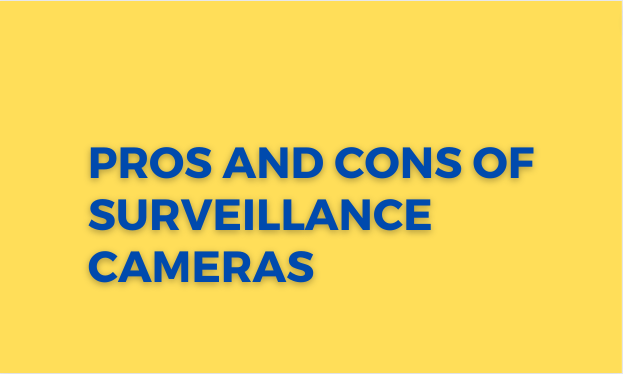Surveillance cameras, also known as security cameras, are widely used in various settings for monitoring and recording activities. These cameras have become an integral part of modern security systems and serve several purposes. Here are pros and cons of surveillance cameras:
Pros:
- Crime Deterrence: Surveillance cameras can deter criminal activity and serve as a visible deterrent.
- Enhanced Public Safety: Cameras can help monitor public spaces and aid in the detection of suspicious or dangerous behavior.
- Evidence Collection: Surveillance footage can provide valuable evidence in investigations and aid in the prosecution of crimes.
- Traffic Monitoring: Cameras can assist in traffic management and improve road safety.
- Employee Monitoring: Surveillance can help monitor employee behavior and ensure compliance with workplace policies.
- Prevention of Workplace Incidents: Cameras can help prevent workplace accidents and monitor hazardous areas.
- Monitoring Vulnerable Areas: Cameras can be deployed in vulnerable areas such as schools or hospitals to enhance security.
- Remote Surveillance: Surveillance systems allow remote monitoring, providing real-time access to video feeds.
- Public Accountability: Cameras can help hold individuals and institutions accountable for their actions.
- Identification of Suspicious Individuals: Surveillance footage can aid in identifying suspects in criminal investigations.
- Protection of Assets: Cameras can safeguard property, assets, and valuable items.
- Emergency Response Assistance: Surveillance systems can aid emergency responders by providing valuable situational awareness.
- Preventing Vandalism and Graffiti: Cameras can deter vandalism and help identify vandals.
- Monitoring Public Events: Surveillance can enhance safety and crowd management during public events.
- Monitoring Industrial Processes: Cameras can monitor industrial processes and ensure compliance with regulations.
- Preventing Terrorism: Surveillance cameras can help identify suspicious activities related to potential terrorist threats.
- Gathering Statistical Data: Surveillance systems can collect data for research and statistical analysis.
- Assisting in Accident Investigations: Cameras can capture accident scenes and assist in determining liability.
- Protection of Personal Property: Surveillance can deter theft and protect personal property in public spaces.
- Reduced Insurance Costs: Surveillance systems can potentially lead to reduced insurance premiums for businesses.
Cons:
- Privacy Concerns: Surveillance cameras can infringe upon individuals’ privacy rights and lead to a sense of constant monitoring.
- Misuse and Abuse: Cameras can be misused or abused by authorities or individuals for unethical purposes.
- Chilling Effect on Free Expression: The presence of surveillance cameras can inhibit individuals from freely expressing themselves.
- Data Security Risks: Surveillance systems can be vulnerable to hacking or unauthorized access, compromising sensitive data.
- Bias and Discrimination: Surveillance cameras can perpetuate biases and contribute to racial or ethnic profiling.
- Ineffectiveness in Crime Prevention: Critics argue that surveillance cameras have limited effectiveness in preventing crimes.
- High Costs: Implementing and maintaining surveillance systems can be costly for businesses and public institutions.
- False Sense of Security: Relying solely on surveillance cameras can create a false sense of security and neglect other security measures.
- Civil Liberties Concerns: Cameras can be seen as intrusive and infringe upon civil liberties, such as the right to privacy.
- Lack of Transparency: Surveillance systems may lack transparency, leading to concerns about who has access to the footage.
- Deterioration of Trust: The presence of surveillance cameras can erode trust between communities and authorities.
- Limited Effectiveness in Low-Light Conditions: Surveillance cameras may struggle to capture clear footage in low-light or nighttime conditions.
- Privacy in Private Spaces: Cameras in private spaces, such as restrooms or changing rooms, raise significant privacy concerns.
- Stifling Innovation and Creativity: Surveillance cameras may discourage individuals from engaging in innovative or creative activities due to self-consciousness.
- Potential for Manipulation: Surveillance footage can be edited or manipulated to fit specific narratives or agendas.
- Overreliance on Surveillance: Relying too heavily on surveillance cameras can divert attention from addressing underlying social issues.
- Lack of Consent: Individuals may not provide informed consent for their image or activities to be captured by surveillance cameras.
- Malfunction and Technical Limitations: Cameras can experience technical issues, leading to missed footage or false information.
- Invasion of Personal Space: Surveillance cameras can intrude upon personal spaces and disrupt individuals’ sense of autonomy.
- Normalization of Surveillance Culture: An excessive presence of surveillance cameras can normalize a culture of constant monitoring.
Pros
- Crime Deterrence
- Enhanced Public Safety
- Evidence Collection
- Traffic Monitoring
- Employee Monitoring
- Prevention of Workplace Incidents
- Monitoring Vulnerable Areas
- Remote Surveillance
- Public Accountability
- Identification of Suspicious Individuals
- Protection of Assets
- Emergency Response Assistance
- Preventing Vandalism and Graffiti
- Monitoring Public Events
- Monitoring Industrial Processes
- Preventing Terrorism
- Gathering Statistical Data
- Assisting in Accident Investigations
- Protection of Personal Property
- Reduced Insurance Costs
Cons
- Privacy Concerns
- Misuse and Abuse
- Chilling Effect on Free Expression
- Data Security Risks
- Bias and Discrimination
- Ineffectiveness in Crime Prevention
- High Costs
- False Sense of Security
- Civil Liberties Concerns
- Lack of Transparency
- Deterioration of Trust
- Limited Effectiveness in Low-Light Conditions
- Stifling Innovation and Creativity
- Potential for Manipulation
- Overreliance on Surveillance
- Lack of Consent
- Malfunction and Technical Limitations
- Invasion of Personal Space
- Normalization of Surveillance Culture



